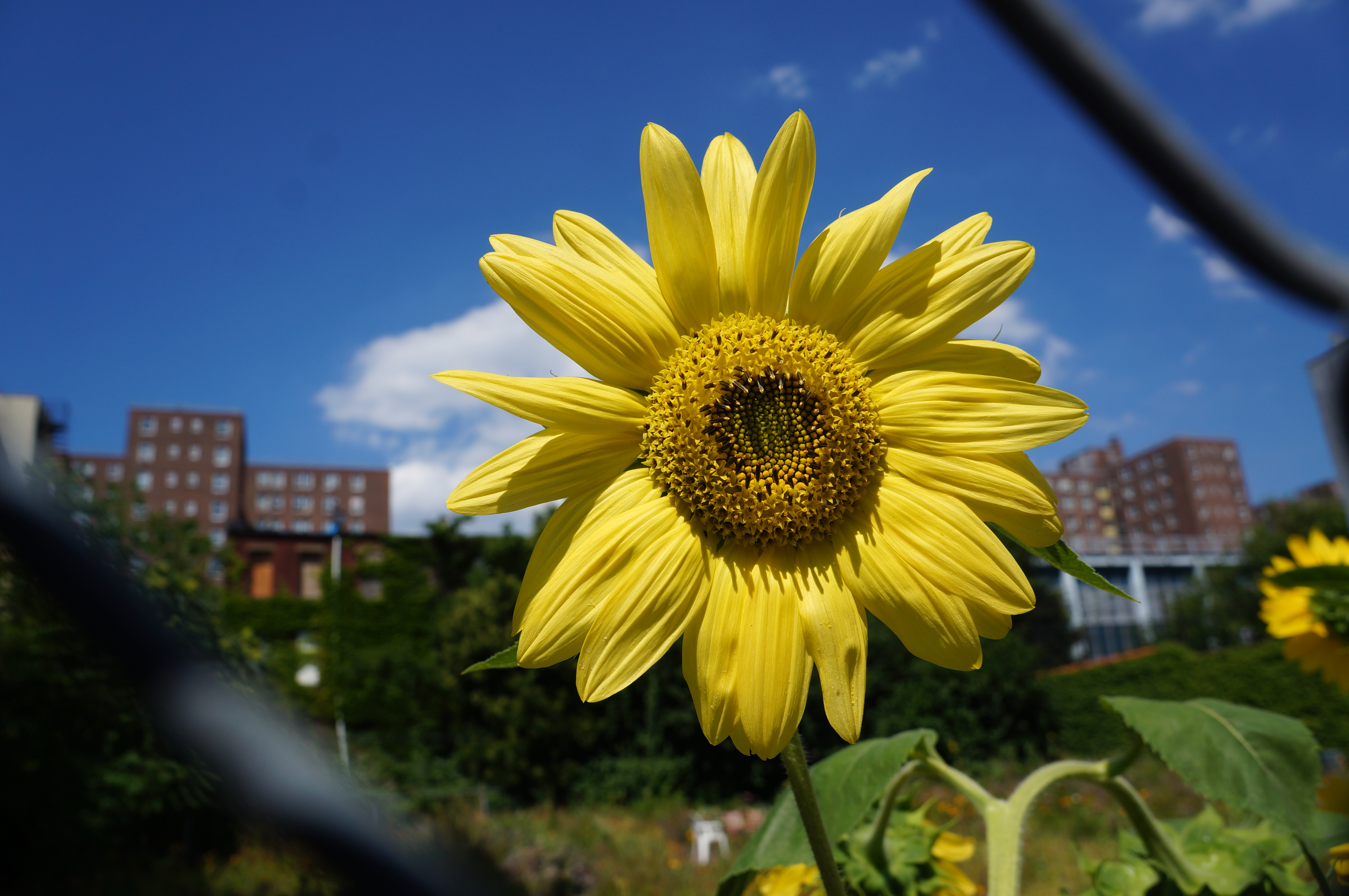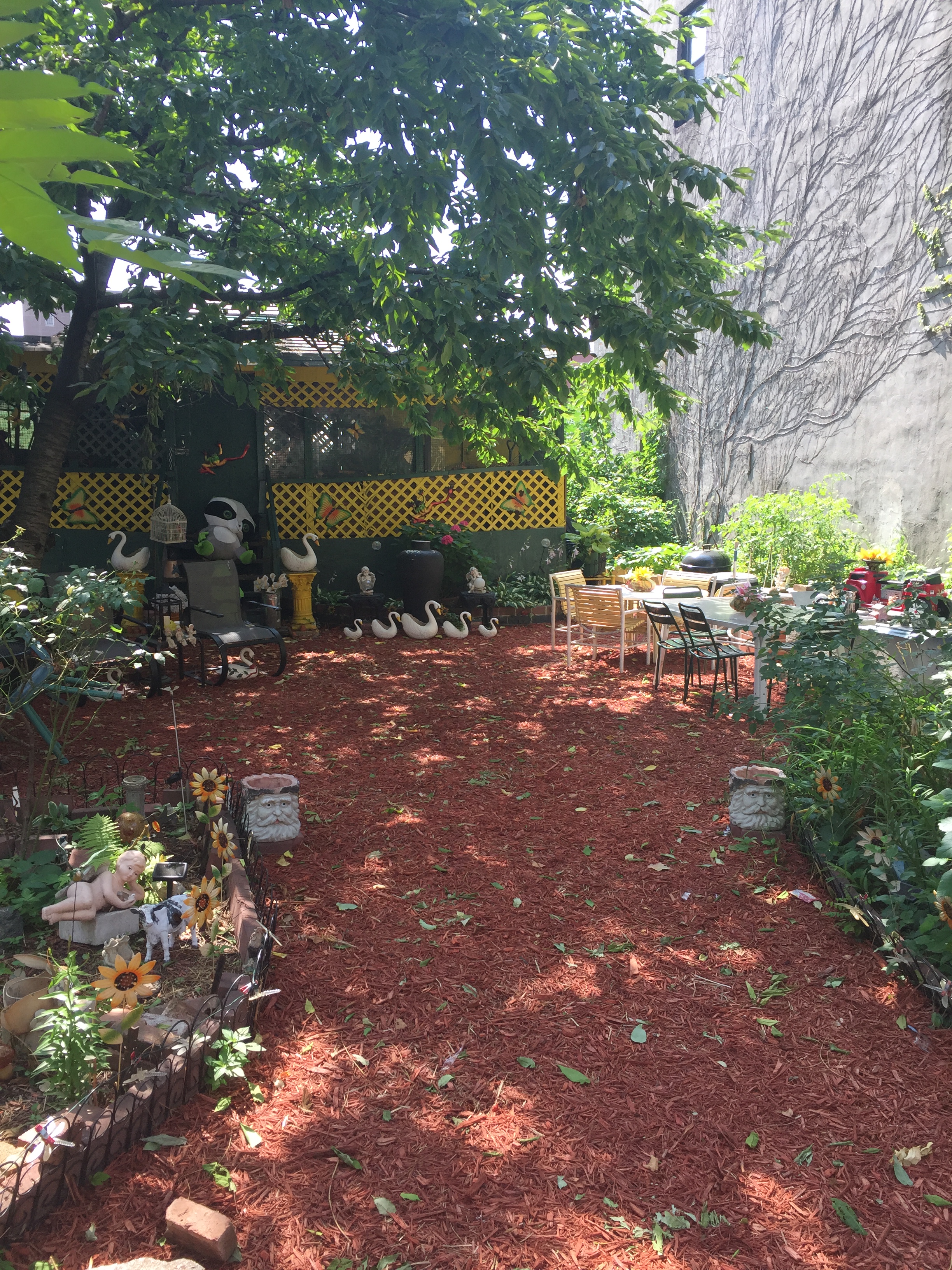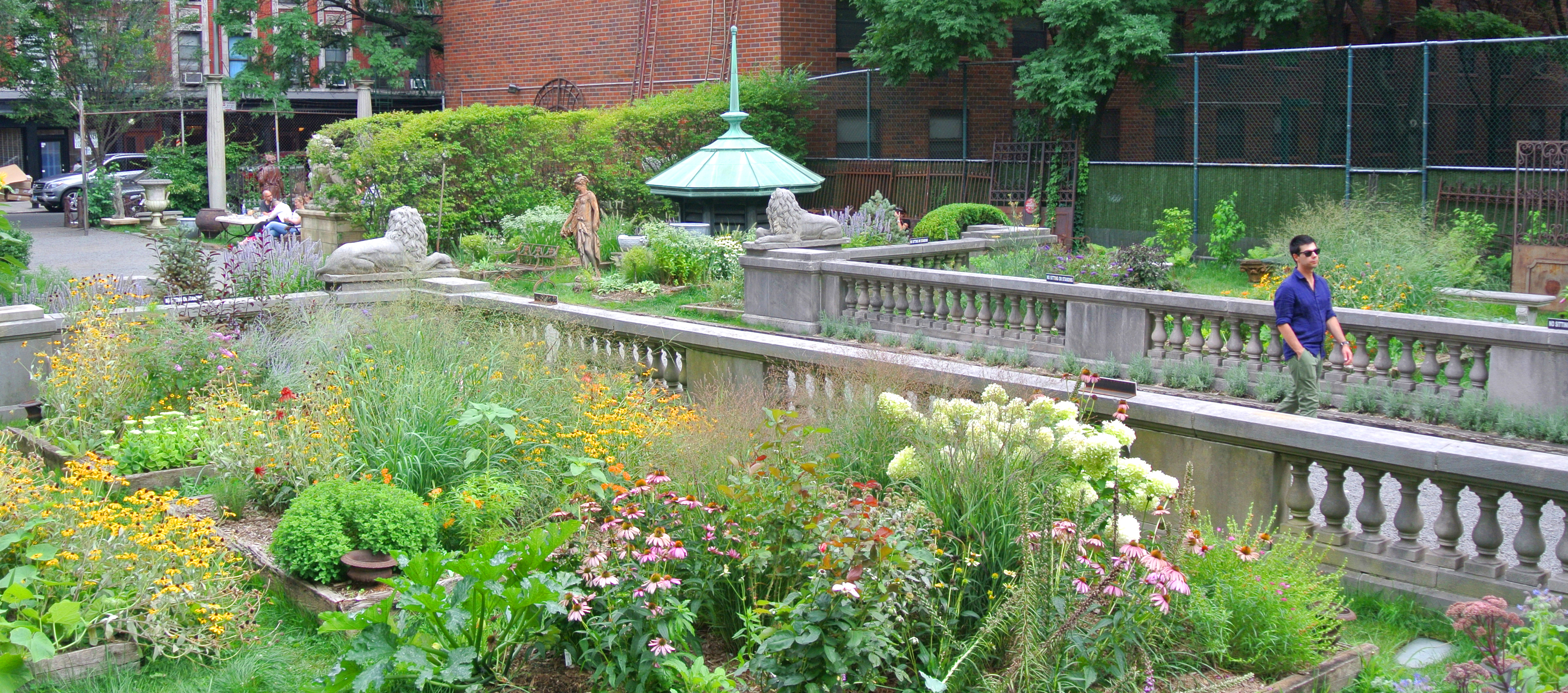Community Gardens Fight Against Developers and the City for Survival
By Rebecca Baird-Remba July 19, 2017 9:45 am
reprints
On West 126th Street, right behind the Apollo Theater, a riot of wildflowers has erupted on what was once an empty, concrete-covered lot. Bright pink cosmos, tall, sunburst yellow black-eyed susans, red poppies, sunflowers, violet bachelor buttons, little white baby’s breath, pink candy tufts, and fuschia echinacea blooms are just some of the flowers growing at Mandela Community Garden.
But the man-made meadow might not be long for this world. It’s one of several gardens fighting the city’s plan to build affordable housing on publicly owned garden lots. As part of Mayor Bill de Blasio’s push to develop 80,000 affordable units of housing by 2024, in January 2015 the city’s Department of Housing Preservation and Development (HPD) released a list of 43 gardens on publicly owned lots that were ripe for redevelopment. At the end of that year, officials announced that 34 gardens would be preserved and transferred to the New York City Department of Parks & Recreation, and the nine remaining gardens would eventually host 800 below-market-rate apartments.
The Mandela Garden sits on HPD land. Last fall, the housing agency chose Harlem-based Lemor Development to build 29 affordable rentals on the lot at 267 West 126th Street between Frederick Douglass and Adam Clayton Powell Boulevards. The apartments will rent to residents earning between 80 and 130 percent of the city’s Area Median Income, which for a family of four means households earning between $69,000 and $110,000. The ground floor will include space for a restaurant and a tech incubator called Silicon Harlem.

Garden founder Rene Calvo argues that Lemor’s project isn’t affordable for the neighborhood, where the median household income hovers around $34,400, versus $52,700 citywide. He asked why HPD has to build on the three-year-old garden, when the city owns more than 1,100 vacant properties across the five boroughs, according to a study released last year by City Comptroller Scott Stringer’s office. Calvo also pointed to a different comptroller study that unearthed an estimated 2,300 vacant New York City Housing Authority apartments, which could serve as much-needed affordable housing but were empty because of needed repairs.
“There’s already been a finding by the community board that there’s a paucity of green spaces, so why would they get rid of one of the few green spaces they have?” he asked. “It would cost tens of millions to build a new park. Why don’t they just build this project somewhere else?”
Calvo hasn’t tried negotiating with the developer, which has helped save other at-risk gardens in Harlem. Over on East 111th Street, four community gardens—Mission Garden, Chenchitas Garden, Villa Santurce Jardinera and Villa Santurce—on a city-owned block faced extinction when the the mayor announced plans to build 655 rental units there. But the developer, Jonathan Rose Companies, agreed to work with officials and the gardeners to carve out new garden spaces next to the planned building, dubbed Sendero Verde.

Down in Little Italy, Elizabeth Street Garden faces the same dilemma as Mandela. Last fall, the city issued a request for proposals for a developer to build senior affordable housing on the lot that runs through the block from Elizabeth to Mott Streets, between Spring and Prince Streets. While HPD has not yet chosen a developer for the 20,000-square-foot site, nonprofit Asian Americans for Equality is reportedly in the running to build a seven-story project there, The New York Post reported in May. The agency is also considering proposals from Philadelphia-based Pennrose and New York Foundation for Senior Citizens.
The gardeners have suggested an alternate development site at 388 Hudson Street in Hudson Square, but the city insists on pushing forward with plans for housing on the garden. Jeannine Kiely, who heads the Friends of Elizabeth Street Garden, argued that the 25,000-square-foot Hudson Street site, if rezoned to match the nearby St John’s Terminal property, could accommodate much more housing than the garden.
But Councilwoman Margaret Chin, whose district includes the garden, won’t budge on developing low-income senior housing there. Her office claims that the city tried to strike a compromise by pushing developers to include at least 5,000 square feet of public space in their proposals.
“With nearly 200,000 seniors languishing on a waitlist for affordable housing across our city, Councilmember Chin has pledged to fight to make sure that everyone has the opportunity to age with dignity in the communities that they helped build,” Chin’s office said in a statement. “Though the site on Hudson and Clarkson streets isn’t in her Council District, she supports any effort to include affordable housing on that site. She also strongly supports the inclusion of up to 100 units of affordable housing in the heart of Little Italy in her own council district that will have at least 5,000 square feet of public open space for everyone to enjoy.”

Still, garden supporters are unhappy with that option, which would give them a quarter of the current square footage and put the green space in the shade, behind a new building.
“Councilmember Chin is leaving housing on the table that they could get without a fight at the alternative site,” Kiely said. “I’m really baffled as to why the alternative site is not being considered. It could be a win-win for seniors, a win-win for the city. Is there something else going on?”
Terri Cude, who chairs Community Board 2, explained that her community district, which stretches from Bowery to the Hudson River and from Canal to West 14th Streets, includes both properties. Seniors who live in the neighborhood will benefit regardless of which site is developed, because the city gives residents of the district preference for 50 percent of the apartments in an affordable development. However, the Hudson Street lot is located in Councilmember Corey Johnson’s district. Garden backers assume that’s why Chin doesn’t support building there instead of the Elizabeth Street Garden.
Cude argues that upwards of 350 apartments could be built on the Hudson Street property, and it’s already across the street from the large James J. Walker Park. And it would be located down the block from the St. John’s Terminal site, which is slated to have nearly 500 below-market rentals, with a third of those units set aside for seniors.
“You’re serving more of your constituents by giving them five times as many chances of getting into an elevator building that’s right near a park,” Cude said. “And it’ll be right near 550 Washington Street, which has been designed with 156 units of senior affordable housing. There’s a good chance you’ll get a lot more senior-focused services.”
However, the vast majority of the city’s community gardens are protected from development because they’re either owned by a land trust, such as the Brooklyn-Queens Land Trust or the Trust for Public Land, or by the Parks Department. The agency’s GreenThumb program was established in 1978 to help coordinate long-term leases and deed transfers for gardens. Today, GreenThumb (which is funded by federal community development block grants, soon to be cut as part of President Donald Trump’s dramatic plan to financially gut the U.S. Department of Housing and Urban Development) oversees 600 gardens across the five boroughs.
Despite city protections for gardens, community groups have been battling for decades to rescue their plots from the wrecking ball. The most famous showdown happened under Mayor Rudy Giuliani, who threatened to auction off 115 community gardens in 1999. During a press conference announcing the plan, he reportedly declared, “This is a free-market economy—welcome to the era after communism.”
Two nonprofit land trust groups reached a deal to purchase the gardens on the chopping block, but gardeners remained concerned that the city would put more gardens up for sale. Then-Attorney General Eliot Spitzer stepped in and sued the city to prevent the sale of the city’s 400 other gardens, arguing that the auction violated state environmental laws. After three years in court, the city—by then governed by Mayor Michael Bloomberg—agreed to preserve the remaining 400 gardens, transferring some to the Parks Department and others to nonprofit groups. As part of the deal, an additional 150 gardens were earmarked for the construction of 2,000 apartments.
Aresh Javadi, an artist and activist who helped organize gardeners against Giuliani’s plan with his nonprofit, More Gardens!, argued that the city should require more community green spaces as part of de Blasio’s push for new housing.
“We as community gardens think that for every 500 units, there should be a garden provided for the community,” he said. “They can build 200,000 units of housing, and they can create those green spaces, too. We don’t want to leave behind a city that’s all concrete.”
Then there are a handful of gardens that sit on privately owned land, often on long-abandoned lots with questionable deeds and ownership. Since they sometimes face legal challenges and a lengthy public review in order to gain city protection, privately owned gardens typically have a steeper hill to climb if they want to avoid development.
Recently, one of those gardens scored a major victory and a promise of Parks Department ownership. In April, the city began the public review process to acquire the Maple Street Community Garden at 237 Maple Street in Prospect Lefferts Gardens, Brooklyn. Borough President Eric Adams and Councilmember Mathieu Eugene earmarked $1.3 million in city funding to purchase the garden and eventually transfer it to the Parks Department.
But the garden’s future didn’t look so bright in 2014. Back then, the two principals of the LLC that claimed to own the property—Michael and Joseph Makhani—tried to force the garden out, the Observer reported last year. They ripped down signs on the garden’s fence and threatened volunteers. A week later, a moving crew showed up, equipped with an eviction notice, and began tearing up raised beds of vegetables. Several months later, the Makhanis filed plans to build a five-story, 17-unit residential project on the property, according to New York City Department of Buildings records.
A nonprofit group that helps neighbors build gardens on vacant land, 596 Acres, and its then-director, attorney Paula Segal, stepped in to prevent the eviction and took the Makhanis to court. A Brooklyn judge declared that the property’s deed was “of dubious validity” and appointed a guardian to help track down the rightful owner. While the courts and Segal sort out the ownership, the city will move forward with steps to buy the garden.
Several miles north in Bushwick, Eldert Street Garden is grappling with a similarly sordid paper trail over its lot at 315 Eldert Street. Segal, who is now a senior staff attorney for the Community Development Project at the Urban Justice Center, helped the garden stave off an eviction in the fall of 2015. Earlier that year, the lot’s owners, Eldert Bushwick House LLC, had filed plans to develop a four-story, eight-unit building.
“They were able to get in and evict us without actually taking us to court,” said Rodrigo Gonzalez, who started the garden with neighbor Kim Anderson. “We were never notified.”
Gardeners got permission to use the lot in 2009 from the board members of a long-defunct neighborhood nonprofit called Alianza de Damas Unidas de Brooklyn. Then in September 2014, a man named Ari Herczl purchased the property for $300,000. He flipped the property the next day for $500,000 without filing a deed, according to court filings from the attorney general’s office. Elba Roman, who hasn’t been on the organization’s board for more than 20 years, according to tax documents, signed off on the sale on behalf of the organization.
But the sale wasn’t approved by the attorney general’s office, as is required by state law for properties owned by charities, according to Segal, who is also handling Eldert Street’s case. And Alianza’s board president, Heriberto Mateo, swore in an affidavit that the nonprofit never approved the sale. The attorney general’s office has been investigating the sale since 2015, according to court filings. The AG’s office declined to comment on the investigation.
Much like at Maple Street, it seems the owners are trying to make a quick buck without putting much thought into dealing with the garden.
“These developers, they’re not from the neighborhood. They just came in and they want to make a million dollars in two days,” Gonzalez said. “They don’t care about the community they’re trying to profit from, they just want us to be out of the way.”
The gardeners feel stuck, because the lot can’t be acquired by the city while the property’s ownership is tied up in court, and they haven’t been able to make headway with a local land trust. They return to court on July 26, when a judge will hear oral arguments about whether the property’s strange sale was legal. Even though they’re starting to run out of money, the gardeners don’t want to give up just yet.
“We have a strong community of people and we’ve been working with other community gardens throughout the years,” Gonzalez said. “There is something to be said for standing up for the kind of places people in your neighborhood are willing to fight for.”


